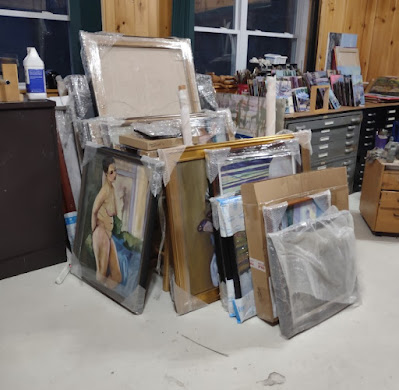I’m flailing around in the undergrowth in this new-to-me medium.
 |
Last fall, I made the commitment that I’d spend a day a week this winter writing a painting book. That should be easy; after all, I’ve been blogging on the subject since 2007 on this platform (and still earlier on WordPress). I’ve almost as much experience as a writer as I have as a painter. Writing is an ‘unconsciously competent’ skill for me, or so I thought.
I have an outline and a plan. That’s the writerly equivalent of a value sketch, right? If I continue with the model of painting, I should then rough out each chapter (my underpainting, in big shapes), and then do a final pass for details.
 |
|
Saran Wrap Cynic, 24X20, is heading to Rye Arts Center for the month of March |
I’m not finding it works that way. I keep forgetting where I am, so I stop to reread what I already have. I then get sucked into editing. But if I forge ahead without checking my place, I inevitably repeat myself.
I need illustrations, especially of the exercises, so I stop to paint them. That’s probably a mistake, but I’m unsure of myself, blundering ahead.
I’m not clear on how long this book should be. I’ve gotten about 9500 words so far, and you, dear student, have just learned how to transfer your sketch to canvas. Arthur Wesley Dow wrote an exhaustive painting book, but I don’t think that will work for modern readers. We like looking at pictures.
 |
|
Pinkie, pastel, 6X8, is heading to Rye Arts Center for the month of March. |
After major surgery eight years ago, I amused myself during my recovery by writing a novel. I had no trouble leaving the hero on the edge of a precipice, taking a nap, and then jumping back to his rescue. Perhaps it was because I was temporarily benched with few other distractions.
I realized that writing just one day a week gives me too much time to forget what I’ve done. I’ve ramped that up to two days a week—just temporarily, mind you, until I find my groove. That’s definitely helped, but it wipes out any time I have for actual painting. Teaching currently occupies the better part of two days. Marketing owns another.
Ten years ago, I’d have felt terrible about that, as if I was a poseur—someone who talks the talk but doesn’t walk the walk. Right now, I’m treating it like a necessary evil, and taking my joy in painting the examples for the book.
 |
| The paintings are nestled all snug in their beds… |
But, if after this predicted Nor’easterpasses, one of my buddies texts me and says, “Carol, let’s go paint snow,” I’m outta here in a flash.
This week, curator Kicki Storm and I worked out the layout for my upcoming show at the Rye Art Center. The paintings are packed and waiting in the middle of my studio. The trailer is ready to roll. I’m chuffed to see these paintings heading down to a larger audience. If you’re on my mailing list, I’ll be sending you out the video tomorrow. If not, why not? Email me here, and I’ll fix that.








